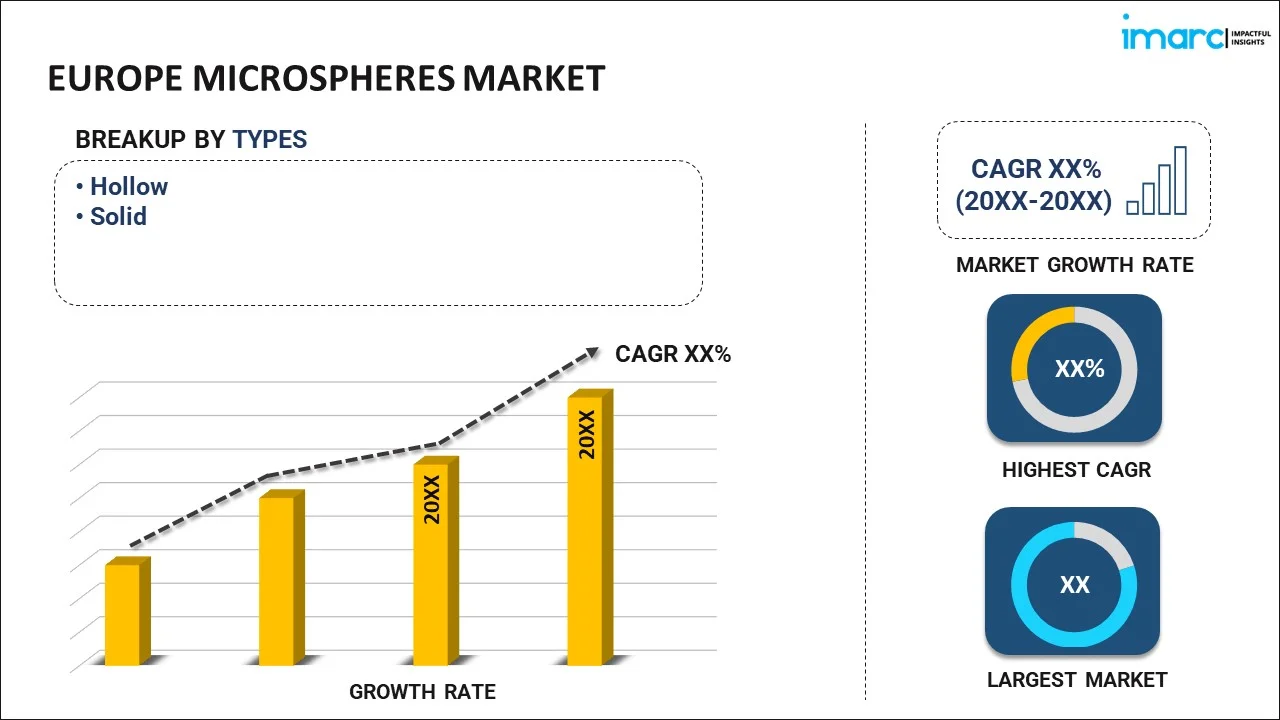
Europe Microspheres Market Report by Type (Hollow, Solid), Raw Material (Glass, Ceramic, Fly Ash, Polymer, Metal, and Others), Application (Construction Composites, Medical Technology, Life Science & Biotechnology, Paints & Coatings, Cosmetics & Personal Care, Oil & Gas, Automotive, Aerospace, and Others), and Country 2025-2033
Market Overview:
The Europe microspheres market size reached USD 1.9 Billion in 2024. Looking forward, IMARC Group expects the market to reach USD 3.6 Billion by 2033, exhibiting a growth rate (CAGR) of 7.22% during 2025-2033.
|
Report Attribute
|
Key Statistics
|
|---|---|
|
Base Year
|
2024
|
|
Forecast Years
|
2025-2033
|
|
Historical Years
|
2019-2024
|
|
Market Size in 2024
|
USD 1.9 Billion |
|
Market Forecast in 2033
|
USD 3.6 Billion |
| Market Growth Rate (2025-2033) | 7.22% |
Microspheres are spherical nanoparticles that are biocompatible and biodegradable in nature and are available in the form of a free-flowing powder. They have distinct quality, uniformity and particle size and consist of proteins and synthetic polymers with specific properties. Some of the commonly used microspheres include floating, magnetic and metal microspheres. They are manufactured using glass, ceramic, polymers and metals and are available in the form of beads, balls and micro balloons. They are widely utilized in drug discovery, clinical diagnostics and biomedical research and also find extensive applications across the construction, medical, chemical and cosmetic industries.
The growing usage of microspheres in the medical industry is one of the key factors creating a positive outlook for the market. Microspheres offer controlled release properties while assisting in improving the therapeutic efficiency of the drugs, due to which they are used in the drug delivery systems. Furthermore, microspheres are also used for bone tissue engineering and in the development of embolic bead products used for treating hypervascular tumors. These factors, collectively, are providing a thrust to the market growth. Additionally, an enhanced focus on sustainable development is acting as another major growth-inducing factor. Furthermore, there is a rising demand for hollow glass microspheres (HGMS) for the manufacturing of foamed concrete due to their lightweight and enhanced thermal insulation properties.
Key Market Segmentation:
IMARC Group provides an analysis of the key trends in each segment of the Europe microspheres market report, along with forecasts at the regional and country levels from 2025-2033. Our report has categorized the market based on type, raw material, and application.
Breakup by Type:

- Hollow
- Solid
Breakup by Raw Material:
- Glass
- Ceramic
- Fly Ash
- Polymer
- Metal
- Others
Breakup by Application:
- Construction Composites
- Medical Technology
- Life Science & Biotechnology
- Paints & Coatings
- Cosmetics & Personal Care
- Oil & Gas
- Automotive
- Aerospace
- Others
Breakup by Country:
- Germany
- France
- United Kingdom
- Italy
- Spain
- Others
Competitive Landscape:
The competitive landscape of the industry has also been examined along with the profiles of the key players.
Report Coverage:
| Report Features | Details |
|---|---|
| Base Year of the Analysis | 2024 |
| Historical Period | 2019-2024 |
| Forecast Period | 2025-2033 |
| Units | Billion USD |
| Scope of the Report | Exploration of Historical and Forecast Trends, Industry Catalysts and Challenges, Segment-Wise Historical and Predictive Market Assessment:
|
| Types Covered | Hollow, Solid |
| Raw Materials Covered | Glass, Ceramic, Fly Ash, Polymer, Metal, Others |
| Applications Covered | Construction Composites, Medical Technology, Life Science & Biotechnology, Paints & Coatings, Cosmetics & Personal Care, Oil & Gas, Automotive, Aerospace, Others |
| Countries Covered | Germany, France, United Kingdom, Italy, Spain, Others |
| Customization Scope | 10% Free Customization |
| Post-Sale Analyst Support | 10-12 Weeks |
| Delivery Format | PDF and Excel through Email (We can also provide the editable version of the report in PPT/Word format on special request) |
Key Questions Answered in This Report
The Europe microspheres market was valued at USD 1.9 Billion in 2024.
We expect the Europe microspheres market to exhibit a CAGR of 7.22% during 2025-2033.
The rising demand for microspheres in the production of elastics, plastics, steel, automobiles, etc., as they are lightweight and have portability and high compression abilities, is primarily driving the Europe microspheres market.
The sudden outbreak of the COVID-19 pandemic had led to the implementation of stringent lockdown regulations across several European nations, resulting in the temporary closure of numerous end-use industries for microspheres.
Based on the type, the Europe microspheres market can be categorized into hollow and solid. Currently, hollow exhibits a clear dominance in the market.
Based on the raw material, the Europe microspheres market has been segmented into glass, ceramic, fly ash, polymer, metal, and others. Among these, glass currently holds the largest market share.
Based on the application, the Europe microspheres market can be bifurcated into construction composites, medical technology, life science & biotechnology, paints & coatings, cosmetics & personal care, oil & gas, automotive, aerospace, and others. Currently, construction composites account for the majority of the total market share.
On a regional level, the market has been classified into Germany, France, United Kingdom, Italy, Spain, and others, where Germany currently dominates the Europe microspheres market.
Need more help?
- Speak to our experienced analysts for insights on the current market scenarios.
- Include additional segments and countries to customize the report as per your requirement.
- Gain an unparalleled competitive advantage in your domain by understanding how to utilize the report and positively impacting your operations and revenue.
- For further assistance, please connect with our analysts.
 Inquire Before Buying
Inquire Before Buying
 Speak to an Analyst
Speak to an Analyst
 Request Brochure
Request Brochure
 Request Customization
Request Customization




.webp)




.webp)












